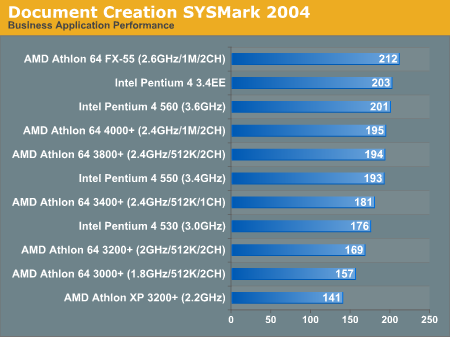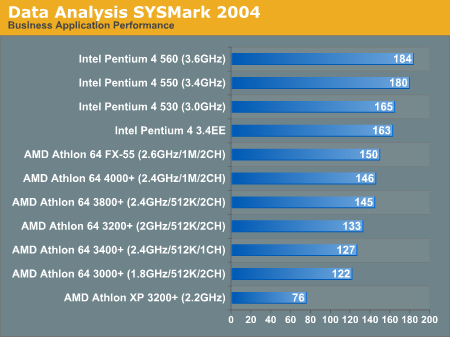AMD Athlon 64 4000+ & FX-55: A Thorough Investigation
by Anand Lal Shimpi on October 19, 2004 1:04 AM EST- Posted in
- CPUs
Business/General Use Performance
Business Winstone 2004
Business Winstone 2004 tests the following applications in various usage scenarios:
. Microsoft Access 2002
. Microsoft Excel 2002
. Microsoft FrontPage 2002
. Microsoft Outlook 2002
. Microsoft PowerPoint 2002
. Microsoft Project 2002
. Microsoft Word 2002
. Norton AntiVirus Professional Edition 2003
. WinZip 8.1
AMD has always dominated performance under business applications, which is why in the past they have always been known as a good CPU maker for office applications. Obviously with the K7 and K8 series of processors AMD changed the rules of the game a bit, offering top of the line performance in far more than just office applications. However, despite AMD's improvements in performance elsewhere, the Athlon 64 continues to hold on as the fastest processor for business applications.
Here we see that there is no performance difference between the three 2.4GHz parts, which is to be expected considering the relatively small datasets and correspondingly low bandwidth nature of business applications.
Even the entry level Athlon 64 3200+ is able to outperform Intel's top of the line Pentium 4 560 here. While Intel will argue that performance here doesn't matter, what does matter is that AMD is faster at a lower price point. Even the old Athlon XP 3200+ is able to offer performance similar to the Pentium 4 550.

Office Productivity SYSMark 2004
SYSMark's Office Productivity suite consists of three tests, the first of which is the Communication test. The Communication test consists of the following:
"The user receives an email in Outlook 2002 that contains a collection of documents in a zip file. The user reviews his email and updates his calendar while VirusScan 7.0 scans the system. The corporate web site is viewed in Internet Explorer 6.0. Finally, Internet Explorer is used to look at samples of the web pages and documents created during the scenario."
While the Athlon 64 FX-55 and 4000+ manage to land on top, it isn't by a huge margin. The FX-55 holds just under an 8% performance advantage over Intels Pentium 4 3.4EE. The Pentium 4 550 and Athlon 64 3800+ tie in the middle, while the 3400+ offers statistically similar performance.
What's interesting to note here is that the Athlon XP 3200+ manages to outperform, ever so slightly, the newer Athlon 64 3000+, thanks to a somewhat shorter pipeline and higher clock speed. What these results tell us is that the Communication test is much less dependent on the memory subsystem, rendering the on-die memory controller advantages of the Athlon 64 relatively useless. Our theories are confirmed by the fact that there's virtually no difference in performance in the single and dual channel memory configurations of the Athlon 64. There is, however, a boost in performance when going from a 512KB cache to a 1MB cache (3800+ -> 4000+), indicating that the datasets here are too big for a 512KB cache, but fit much better in a 1MB cache.
The Pentium 4 does relatively well here, with the Prescott based 90nm 560 offering similar performance to the Northwood based 130nm 3.4EE, with the higher clock speed able to make up for Prescott's other shortcomings.

The next test is Document Creation performance, which shows very little difference in drive performance between the contenders:
"The user edits the document using Word 2002. He transcribes an audio file into a document using Dragon NaturallySpeaking 6. Once the document has all the necessary pieces in place, the user changes it into a portable format for easy and secure distribution using Acrobat 5.0.5. The user creates a marketing presentation in PowerPoint 2002 and adds elements to a slide show template."
The inclusion of a speech recognition test as a part of this next benchmark immediately excludes the older generation of processors from being in the running for top performance spots. The lack of an on-die memory controller keeps the Athlon XP 3200+ at the end of the pack, while the more bandwidth friendly Pentium 4 and Athlon 64 platforms battle it out for the lead here.
The Athlon 64 FX-55 manages to secure a small 5% lead over the 3.4EE and the Pentium 4 560. It's not a noticeable performance lead in the real world, but it does stand on paper (or on web if you prefer). We once again see that there's no huge benefit to the 4000+'s 1MB L2 cache, but the dual channel configuration of our Socket-939 platforms clearly comes in handy, resulting in a 7% performance boost for the 3800+ over the single channel 3400+.

The final test in our Office Productivity suite is Data Analysis, which BAPCo describes as:
"The user opens a database using Access 2002 and runs some queries. A collection of documents are archived using WinZip 8.1. The queries' results are imported into a spreadsheet using Excel 2002 and are used to generate graphical charts."
Although not quite the enterprise level server database, MS Access does get used quite frequently in small to medium sized business environments to handle light database loads.
Here the Pentium 4s completely dominate, with the Prescott core truly extending the performance lead here. None of the AMD chips even stand a chance, not to mention the thrashing that the XP 3200+ gets. The Data Analysis tests do prove that despite the performance in other areas, there are a few pedestals that the Pentium 4 does continue to stand quite high upon.











89 Comments
View All Comments
HardwareD00d - Tuesday, October 19, 2004 - link
Fantastic article, obviously very well thought out.I would have liked to see a comparison between the 4000+ and the "real" FX-53 to really back up your rebadging theory (yeah I know speed+cache+memory width are equal between the two, but just to make sure AMD isn't pulling some magic out of there butt somewhere else).
Marsumane - Tuesday, October 19, 2004 - link
Yes, thanks for the XP comparison. I find it interesting how its not performing as well as it used to in games. (doom 3, farcry, cs:s)Also, your ut2k4 benches seem off. How is doom 3 pulling 50% more frames at the same res? Maybe your ut is at 16x12? I pull similar frames on ut w/ my 9800p oced.
ksherman - Tuesday, October 19, 2004 - link
I like the ending... It sounds mysterious!alexruiz - Tuesday, October 19, 2004 - link
I will suggest again to include some Ulead Video Studio 8.0 benchmarks for video encoding. Ulead is by far the fastest consumer grade video editor / renderer, it is the most complete and one of the most popular. In fact, it is almost 50% faster than Pinnacle 9, and almost 100% faster than videowave.Roxio has really been working with Intel as all previous version of video wave ran better on AMD hardware. As reference, results video wave 6 or 7 would be interesting. Newer doesn't always mean better, as you can see from Adobe Premiere. Version 7.0 is quite slower than 6.5 doing the exact same thing in the same platform.
For DivX encoding, a run with virtualdub/virtualdubmod or DVD2AVI would be nice, as they are very fast and extensively used.
Just some comments
Alex
Araemo - Tuesday, October 19, 2004 - link
Thank you thank you thank you for including an Athlon XP.This allows me to better judge where my current Barton 2.4 Ghz sits. ;P So I know when an upgrade to the next cheap overclocker will give a good enough performance boost to be worth the money.
stephenbrooks - Tuesday, October 19, 2004 - link
Here's an idea to play with: how about some 2D scatter plots of Performance/£ and Performance/Watt? Obviously not on everything - that would clutter it - but perhaps on one or two key things it'd be nice to see.Zar0n - Tuesday, October 19, 2004 - link
EDIT #22 There is no 3400+ for SK 939 only 3500+Zar0n - Tuesday, October 19, 2004 - link
Nice article BUT:You should make C&C power consumption and temperature
Also some OC tests.
The Battle for Value is not correct:
1º WHAT about price of DDR1 VS DDR2?!
2º MB for INTEL are more expensive, ~40€ is a great difference in a MB price.
3º 0.09 AMD are just introduced so they are going to come down, not much but they are.
In order to be fair you should compare with AMD 3400+
AMD as a clear winner here.
mczak - Tuesday, October 19, 2004 - link
power consumption at idle - is this with or without cool 'n' quiet (I suspect without)?Uff - Tuesday, October 19, 2004 - link
I have to agree with #18 - it's not worth paying more than twice the price of a 3400+ just to get 3800+ on 939 platform.Many say 'OH! But s939 is more upgradable!', but if you think about it, by the time you upgrade next there are very likely going to be new motherboards available aswell and you end up upgrading that anyway. Not to mention motherboards cost virtually nothing compared to cpus.